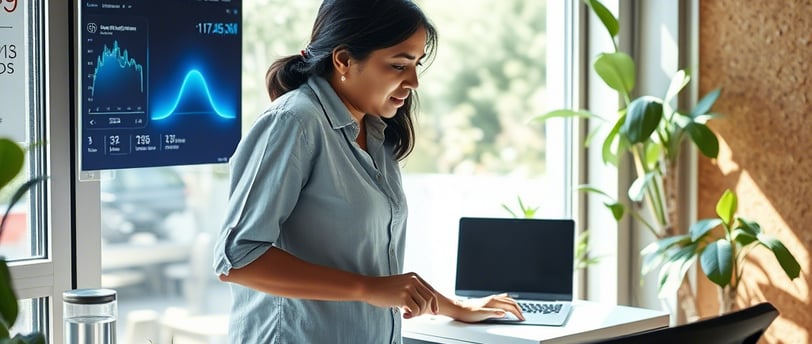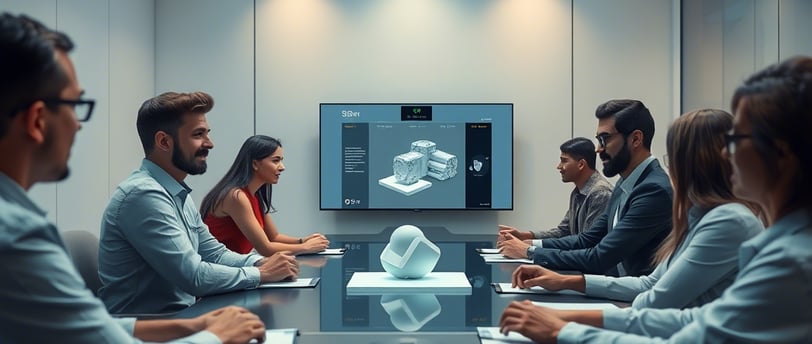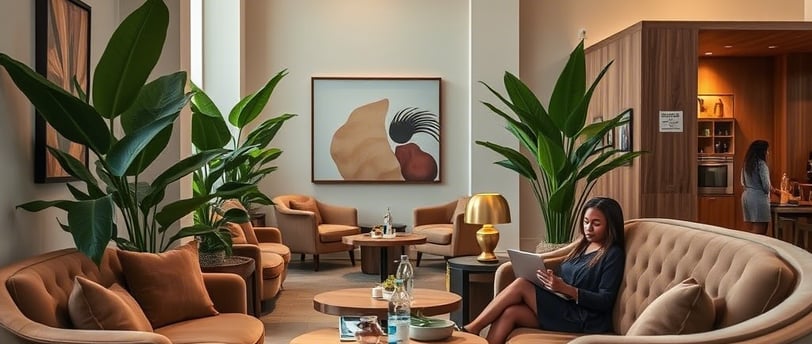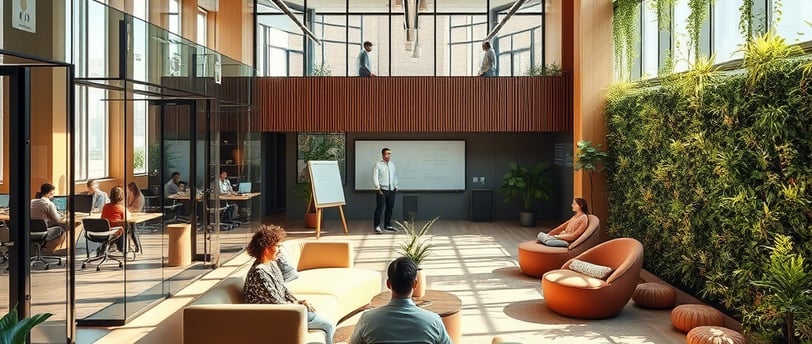The 2025 Hybrid Office: Top 5 Design Trends Merging Tech, Wellness & Flexibility
Post-Pandemic Office Trends Dominating 2025
TSI BLOG
TSI Architects & Engineers
6/3/20256 min read


The pandemic didn't just disrupt how we worked; it fundamentally challenged where and why we gather in physical offices. As we move through 2024 and into 2025, the dust is settling on a transformed landscape. The office is no longer a mandatory daily destination, but a strategic tool – a destination chosen for specific value. This evolution demands a radical rethinking of commercial design, moving beyond mere aesthetics to create environments that actively support new work paradigms, prioritize human well-being, and seamlessly integrate technology. Here are five defining trends shaping the future of workspaces in 2025:
1. The Hybrid Hub: Purpose-Driven Zones, Not Just Desks
The dominance of the "hybrid model" – a blend of remote and in-office work – is undeniable. However, 2025 sees the maturation of this model, moving away from simple hot-desking towards a sophisticated ecosystem of purpose-built zones.
Beyond "Hoteling": While unassigned seating remains common, it's becoming smarter and more intentional. Expect advanced desk-booking systems integrated with calendars, suggesting optimal spaces based on the day's tasks (e.g., quiet focus pod vs. collaborative table). Sensors monitor occupancy, providing data to optimize space allocation and reduce wasted square footage.
Activity-Based Working (ABW) 2.0: Offices are meticulously designed around specific work activities:
Deep Focus Zones: Acoustically sealed pods, library-quiet rooms with sound masking, and distraction-free individual workstations equipped with high-quality monitors and ergonomic chairs.
Collaboration Catalysts: Varied settings from high-tech huddle rooms for quick video calls to larger, flexible project rooms with writable walls, seamless screen sharing, and comfortable, reconfigurable furniture. Think less boardroom, more innovation lab.
Social & Connection Nodes: Intentional spaces designed for informal interaction, mentorship, and spontaneous connection – comfortable lounge areas, well-equipped cafés with barista stations, terraces, and "town hall" spaces for all-hands meetings. These areas are crucial for rebuilding culture and combating remote isolation.
Recharge & Reset Areas: Dedicated quiet rooms for meditation, prayer, or simply taking a mental break, separate from traditional break rooms.
The "Magnet" Office: The physical office in 2025 must offer compelling reasons to commute. It becomes a hub for collaboration, mentorship, culture-building, and accessing specialized tools or environments impossible to replicate at home. Design focuses on creating an experience and fostering belonging.
2. Wellness Woven In: From Perk to Foundational Design Principle
Employee well-being has shifted from a nice-to-have perk to a core business imperative and a fundamental design driver. In 2025, wellness is not just a gym or a plant wall; it's holistically integrated into the fabric of the space.
Biophilic Design Deep Dive: Moving beyond token greenery, expect immersive biophilia. This includes abundant natural light (with dynamic lighting systems mimicking daylight cycles), extensive indoor plantings (including living walls and indoor gardens), natural materials (wood, stone, cork), water features, and views of nature whenever possible. These elements reduce stress, boost cognitive function, and improve air quality.
Indoor Environmental Quality (IEQ) as Standard: Rigorous attention to:
Advanced Air Filtration & Ventilation: HVAC systems with MERV-13+ filters, increased fresh air intake, and potentially real-time air quality monitoring displays (CO2, VOCs, PM2.5) are becoming baseline expectations.
Circadian Lighting: Smart lighting systems that dynamically adjust color temperature and intensity throughout the day to align with natural circadian rhythms, boosting alertness and improving sleep quality.
Thermal Comfort & Control: Zoned HVAC and solutions like personal desk fans or heaters empower individual comfort, acknowledging that one temperature doesn't fit all.
Acoustic Wellbeing: Sophisticated sound masking systems, high-performance acoustic panels, sound-absorbing materials in furniture and finishes, and thoughtful zoning to minimize disruptive noise are critical for focus and reducing auditory stress.
Movement Encouragement: Design actively combats sedentariness:
Centralized stairs made attractive and prominent over elevators.
Sit-stand desks as standard equipment.
Varied seating options (perch stools, balance balls, lounge chairs) encouraging posture changes.
Walking paths, both indoors and on accessible outdoor terraces.
Mental Health & Neurodiversity Support: Dedicated quiet rooms, phone booths for private calls, and sensory modulation spaces (with adjustable lighting and sound) cater to diverse neurological needs and provide essential respite. Access to natural light and views is recognized as vital for mental health.


3. Seamless, Intelligent Tech Integration: The Invisible Enabler
Technology in the 2025 workspace is no longer just hardware on desks; it's the invisible nervous system enabling flexibility, connectivity, and efficiency, while collecting valuable data for optimization.
Unified Workplace Experience Platforms: Single apps or portals handle desk booking, meeting room reservations (with integrated video conferencing controls), wayfinding, service requests (IT, Facilities), colleague location (opt-in), and even building access. Frictionless user experience is paramount.
Smart Meeting Rooms as Standard: Rooms equipped with:
One-touch join for video conferencing (Zoom, Teams Rooms etc.).
Wireless screen sharing from any device.
Intelligent room scheduling panels outside doors showing availability and allowing instant booking.
Occupancy sensors to release no-show bookings automatically.
High-fidelity audio and auto-framing cameras for inclusive hybrid meetings.
IoT & Sensor Networks: Building-wide sensors collect anonymized data on:
Space Utilization: Identifying underused areas to optimize footprint or redesign.
Environmental Conditions: Monitoring temperature, humidity, light levels, air quality in real-time for proactive adjustments and ensuring wellness standards.
Wayfinding & Optimization: Helping employees find available desks, meeting rooms, or colleagues quickly via apps or digital signage.
Enhanced Connectivity & Power: Ubiquitous, high-bandwidth Wi-Fi 6/6E/7 is non-negotiable. Abundant, easily accessible power outlets (AC and USB-C) are integrated into furniture, walls, and floors, supporting a mobile workforce. Wireless charging surfaces become commonplace.
Data-Driven Decision Making: The data harvested from occupancy sensors, booking systems, and environmental monitors provides invaluable insights for Facilities Managers and HR. It informs real estate strategy, identifies pain points, measures the effectiveness of new designs, and justifies investments in workplace improvements.
4. Sustainability as a Core Value Proposition
The focus on Environmental, Social, and Governance (ESG) criteria and heightened employee expectations make sustainable design a critical trend, not just an ethical choice but a business necessity and talent attractor.
Circular Economy Principles: Design prioritizes reuse and refurbishment. Expect more:
Adaptive Reuse: Converting existing buildings rather than new construction.
Modular & Reconfigurable Systems: Furniture and partitions designed for disassembly, reconfiguration, and future reuse, minimizing waste during churn.
Durable, Timeless Materials: Investing in high-quality, long-lasting finishes and furniture that won't need frequent replacement.
Low-Carbon Materials: Specifying materials with verified Environmental Product Declarations (EPDs), high recycled content, rapidly renewable resources (like bamboo, cork), and locally sourced products to reduce embodied carbon.
Energy & Water Efficiency: Beyond standard LEED/WELL requirements, integrating:
Smart lighting and HVAC systems reacting to occupancy and daylight.
High-performance glazing and building envelopes.
Water-efficient fixtures and potentially greywater systems.
Wellness Certifications as Benchmark: Pursuing WELL Building Standard, Fitwel, or LEED with a health focus demonstrates a tangible commitment to employee well-being and sustainability, enhancing employer branding.


5. Hospitality & Residential Inspiration: Comfort as King
To compete with the comfort of home offices and attract employees back, commercial spaces in 2025 increasingly borrow from hospitality and high-end residential design, prioritizing comfort, warmth, and aesthetics.
Warm, Weleting Ambiance: Moving away from sterile corporate aesthetics towards spaces that feel inviting and comfortable. This includes:
Residential-Scale Furniture: Plush sofas, armchairs, coffee tables, side lamps, and area rugs in collaboration and lounge zones.
Warm Material Palettes: Rich woods, textured fabrics (bouclé, linen, wool), natural stone, and warm metal finishes (brass, bronze).
Curated Art & Accessories: Thoughtful artwork, plants, books, and objects that add personality and reflect company culture, creating a sense of place.
Amenities as Experience: On-site amenities become more sophisticated and integrated:
Premium Café Culture: High-quality coffee bars, healthy food options (often subsidized), serving as central social hubs.
Wellness Offerings: Access to fitness classes (yoga, meditation), wellness rooms, or partnerships with nearby gyms.
Concierge Services: Dry cleaning pickup, package handling, or even occasional services like car washes or haircuts (especially in large campuses).
Flexibility & Variety: Offering a diverse range of settings – from cozy nooks to bustling cafe areas to serene focus rooms – caters to different moods, tasks, and personalities, mirroring the variety one might find at home or in a boutique hotel.
Focus on Experience: Every touchpoint, from the lobby reception to the ease of finding a space to the quality of the coffee, is considered part of the employee experience. Design aims to make the office a place people want to be, not just have to be.


The Human-Centric, Agile Workspace
The workspace of 2025 is fundamentally human-centric and purpose-driven. It’s not about mandating presence, but about creating an environment so compelling, supportive, and effective that employees choose to come in. The successful office seamlessly blends the flexibility demanded by hybrid work with the advanced technology needed to connect distributed teams. It prioritizes employee well-being not as an afterthought, but as the bedrock of design, recognizing that healthy, comfortable employees are more engaged, productive, and innovative. Sustainability is woven into its very structure, reflecting corporate values and responsibility.
This evolution requires a shift in mindset from both designers and occupiers. It demands investment in quality, technology, and well-being. It necessitates flexibility in lease structures and a willingness to use data to continuously adapt and optimize. The "one-size-fits-all" office is extinct. In its place rises an agile, responsive ecosystem designed not just for work, but for thriving human potential in the post-pandemic era. The companies that embrace these five trends will not only attract and retain top talent but will also foster the collaboration, innovation, and resilience needed to succeed in the years ahead. The redefinition is well underway, and 2025 marks a significant milestone in this exciting transformation.
TSI Architects & Engineers
© 2024. All rights reserved.
